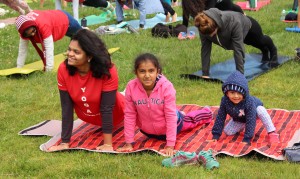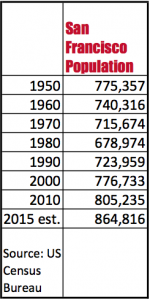
State demographers said San Francisco, San Mateo and Alameda counties would experience declining births. They were wrong.
By Sharon Simonson
With wildly expensive housing and poorly perceived public schools, San Francisco has not enjoyed a reputation as a child-rearing mecca.
As recently as 2010, state demographers predicted the number of births in the city each year would drop by a quarter over the coming decade. Trend lines were the same in Alameda and San Mateo counties.

New U.S. Census Bureau birth estimates illustrate anew the pitfalls of future-telling: the number of babies born each year in both San Francisco and Alameda counties in fact rose from 2010 through 2015 and stayed steady in San Mateo County.
A state demographer says their estimates erred in two, related ways: they anticipated residents in the three counties, including women of child-bearing age, would leave at a greater rate than they did and that fewer new residents would move in to replace them.
“Such assumptions were not unreasonable,” Walter Schwarm of the California Demographic Research Unit said in an email. “(M)any of the Bay Area counties had been growing quite slowly for much of the previous fifteen years (except for the very tail-end of the dot-com boom).”
The state predicted annual declines in San Francisco births starting in 2010. By 2015, an estimated 7,850 babies were to be born. But, according to just-released U.S. Census Bureau data, annual births since 2010 have in fact climbed by about 500 a year to not quite 9,100 in the 12 months that ended in July.
In Alameda County, home to Oakland and Berkeley, the number of annual births has climbed from not quite 19,400 in 2010 to nearly 20,000 five years later. The new San Francisco Supervisors’ mandate that private employers pay for parental leave seems almost certain to increase the number of city births as well.![]()
Population growth is not always synonymous with economic growth, but it can be an important contributor and index. Births are one of only two ways that populations can grow. The other is through the in-migration of people from other places. Strong job creation tends to drive population growth. Birth numbers influence housing demand and school pupil counts. Overall, California is seeing a decline in the number of children.
![]() It’s hard to conceive now with San Francisco’s bustling sidewalks and spectacular redevelopment, but the city lost nearly 100,000 residents from 1950 to 1980. Its population contracted by 12 percent to 679,000 residents. Since then, increase has been steady, but in the last five years the growth rate has been faster that in any of the last three decades: the Census Bureau estimates that in mid-2015, nearly 865,000 people lived in the city, up 7.4 percent from 805,235 people only five years before and nearly 100,000 more than at the previous peak in 1950.
It’s hard to conceive now with San Francisco’s bustling sidewalks and spectacular redevelopment, but the city lost nearly 100,000 residents from 1950 to 1980. Its population contracted by 12 percent to 679,000 residents. Since then, increase has been steady, but in the last five years the growth rate has been faster that in any of the last three decades: the Census Bureau estimates that in mid-2015, nearly 865,000 people lived in the city, up 7.4 percent from 805,235 people only five years before and nearly 100,000 more than at the previous peak in 1950.
Notwithstanding the increased numbers of births, San Francisco’s birth rate—how many children are born each year for every 1,000 people—remains about 85 percent of the nation’s and falling, though ever so slowly. “There are conditions inherent in San Francisco…that make having more than one child less likely,” Schwarm said. “There are still a fair number (of women) that have two, but really only exceptional cases have more than that.”
San Francisco challenges, including limited day care and overall smaller housing size, contribute to women deciding to have fewer children. At the same time, you can’t eliminate “self-selection bias,” he said, “which is to say that some women who move to San Francisco might be more willing to have a smaller family no matter where they lived because they have other priorities.”![]()